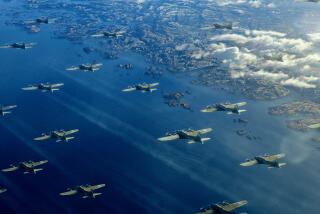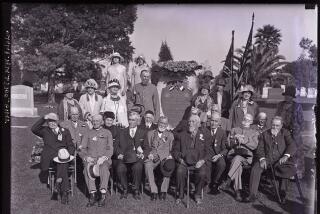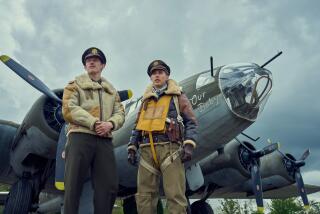Zero Effect
- Share via
The guys who restore and maintain the small collection of World War II airplanes at Camarillo Airport have a tough time keeping these aging American-made war birds in the air.
But their newest mission is putting them to the test. They’re overhauling a rare Japanese Zero fighter plane, one of only three believed to still be flying.
The Zeroes were the feisty little fighters that sneaked up on Pearl Harbor and proved to be the nemesis of the Allied forces throughout the war. They’re the ones that kamikaze pilots loaded with bombs for suicide missions.
This particular one is the latest undertaking of the Confederate Air Force, Southern California Wing, and if you want a glimpse at the restoration, you can visit their hangar and museum at the airport. They tinker with the planes and give free tours from 10 a.m. to 4 p.m. Tuesday, Thursday and Saturday.
The tiny, single-seat Japanese Zero with its red-circle insignia is dwarfed by some of the other vintage warplanes here, including a hulking C-46 twin-engine transport plane that ferried supplies from India to China after the war was in full swing.
If the organization’s improbable name, Confederate Air Force, sounds like someone’s idea of a joke--it is. It all started as a prank in 1957 when a bunch of pilots who had revived a surplus World War II plane came out to the field one day and found someone had painted the name on the fuselage.
They saluted each other as “colonel,” and the name stuck. Today, the organization boasts about 7,000 members worldwide who belong to more than 80 local “wings” like the one in Camarillo.
It was the Camarillo bunch that the Texas-based CAF appealed to when its treasured Japanese Zero--one of its 140 or so restored World War II planes--needed an overhaul.
“We have a good reputation,” said Russell Drosendahl, a retired TWA pilot who flew during the war. Since 1981, the group has worked out of cramped, rustic quarters that include a shop where they even make parts for the vintage warplanes.
The old American-made birds were already a challenge when it came to finding parts and making repairs. But an old, rare Japanese Zero, well that was a doozie of an assignment.
Luck was with them though. When word spread that they were working on the plane, they got a visit from an Oxnard man whose family had made the untimely decision to leave the U.S. and revisit their Japanese homeland just before the bombing of Pearl Harbor.
“His father had to go to war for Japan,” Drosendahl said. The young man had gone to work in a factory that built the Zero fighters, and more than 50 years later he was able to translate some of the aircraft manuals.
The Japanese manufactured more than 10,000 of the little fighters, and today only 33 survive. In addition to the three still airworthy, another three are undergoing restoration, and the rest reside in museums or in storage.
The history of this Zero is a little sketchy. The date it was built and whether it participated in the Pearl Harbor attack isn’t a certainty, but the plane was assigned to a Japanese carrier that was there. In fact, one of the local CAF members, Don McMillan of Ventura, was assigned to the ship that eventually sunk that carrier.
It seems certain that this Zero served in combat over the Solomon Islands. After the war, it was abandoned on an island off the coast of New Guinea, according to a CAF publication. Along with some other Japanese fighter planes, it lay corroding just off a jungle airstrip until the late 1960s when the old wrecks were spotted by someone looking for vintage warplanes to rebuild for movies.
The planes were hauled out, pieced together and the CAF acquired its Zero in the mid-1980s. It was rebuilt eight years ago and was due for more maintenance and restoration when it arrived in Camarillo last fall.
“It wasn’t safe to fly,” Drosendahl said, pointing to corroded parts that will have to be replaced. The work probably will be done by fall when the fighter will be turned over to CAF headquarters, which decides where the planes in its collection will be housed and displayed.
Visitors to the Camarillo wing can peruse a half a dozen or so old warplanes including the Curtiss C-46 Army Air Corps transport, a Grumman F8F-2 Navy Bearcat fighter, a North American SNJ Navy trainer and a North American B-25 Army Air Corps bomber.
The planes are authentically restored--as much as possible--right down to the colorful, and sometimes risque “nose art” on the outside, like the Asian beauty on the C-46, dubbed “China Doll.”
“All through the war, almost all the planes had some nose art,” said John Deakin, a Los Angeles-based airline pilot who frequently works on the C-46. “They were young, healthy boys and they liked good-looking women.”
Another controversy, in these politically correct times, is the organization’s name, which doesn’t seem to bother the members. “The name raises a few hairs, but it all started real innocently,” Deakin said.
The Camarillo wing has big plans for its growing family of planes. Right now their cramped quarters include a museum of sorts, jammed with World War II paraphernalia: radios, gun sights, ammunition, aerial cameras and uniforms. But they’ve got their sights on building a $1-million complex at the airport where they can restore and display their planes. They’ve raised about $140,000 and when they’ve pulled in another $200,000, they plan to break ground, Drosendahl said.
“The airport has given us five years to put it up,” he said. “We’ve got four years left to do it.”
BE THERE
The Confederate Air Force, Southern California Wing, is open for free tours of its restored World War II airplanes at the Camarillo Airport on Tuesdays, Thursdays and Saturdays, 10 a.m. to 4 p.m. For information, call (805) 482-0064.
More to Read
Sign up for The Wild
We’ll help you find the best places to hike, bike and run, as well as the perfect silent spots for meditation and yoga.
You may occasionally receive promotional content from the Los Angeles Times.






